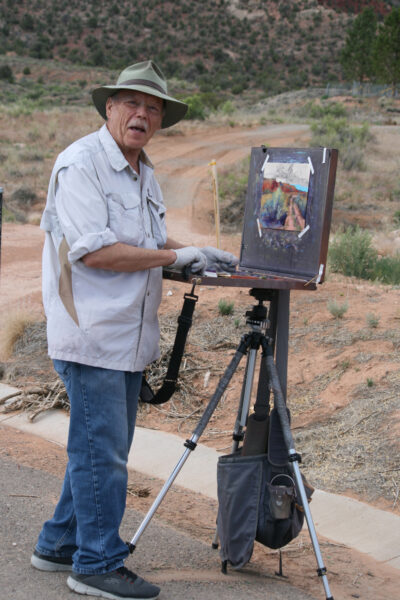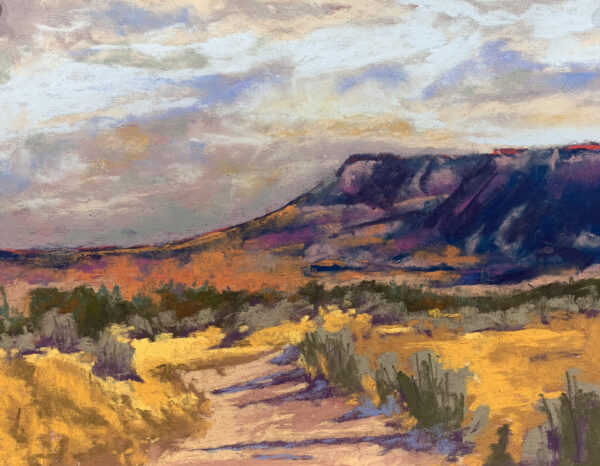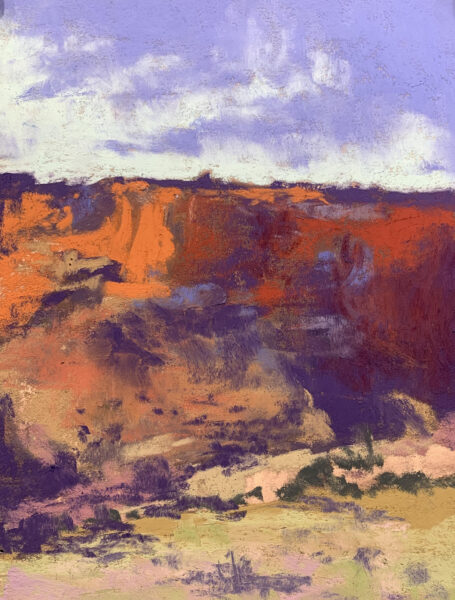By Penny Creasy
A little bit about Mike first:
Mike was born and raised in Colorado. In the beginning, he painted those places that he loved because of the memories associated with them. As he continued to grow as an artist, he became more drawn to the quality of light in Colorado and the west. He loves dissecting the light and the dark within warm and cool shadows creating a push-pull that lures him into every painting. It has become impossible for him to look at things without noticing the quality of light that defines his surroundings.
- Master Signature member Pastel Society of Colorado
- Member of Plein Air Artists of Colorado, American Impressionist Society, Red Rocks Pastel Society Nevada
- Associate Member PSA
- Graduated Cum Laude Regis College, Bachelor of Fine Art, 1990
- Workshops with Lorenzo Chavez, Kim Lordier, Desmond O’Hagen and Dennis Rhoades
Being in Mike Ray’s studio is a perfect place to talk about art. You are surrounded by his art and tools he creates with.
Penny (PC): Do you have any guiding thought when beginning a piece?
Mike (MR): When painting outside, there are an enormous amount of things to see. I’m excited to get started, so I begin by looking for big shapes that are organized in a pleasing way. I sometimes do a thumbnail, but because I’m wanting to get started, I use a large red pastel and block in those shapes, keeping everything loose, and then using alcohol to push things around to where I want them.
PC: I notice you have many small pieces, and I know you paint one almost every day. Would you tell me about that?
MR: I begin by choosing 4 hard pastel colors. My studio faces the Colorado National Monument, and I look to see what is going on. It becomes a meditation session, I think.
PC: What is happening in the Pastel art world that is different from when you first began?
MR: Pastel art time is now. More people are recognizing that it has an enduring place in art. The supplies have improved enormously. The quality of pastels and the paper we can use is so much improved. In the past, it was hard to find the dark rich colors that you need. I credit Terry Ludwig with that giant step. I use them almost exclusively partly because he was my friend and mostly because they are so good.
PC: Many artists are using their phones or computers to self-critique their work, adjust shapes or nudge colors a bit. Do you?
MR: Sometimes I will use my computer to make a thumbnail. I will photograph a piece I am having trouble with, open it on the computer and change it into a black and white and reduce it to a smaller size. The composition or value error will really stand out. When I am plein air painting, I will take a phone photo and use it later when finished to see if I created what I saw and then just delete the photo. I don’t keep them or very often take reference photos. Sometimes I use a mirror and look back over my shoulder and see what I missed.
PC: In doing art there is always something to learn about ourselves.
MR: I think my answer to that is “don’t be afraid of the experience”. If I see two colors I haven’t used together, I try it. I’m not disappointed if they don’t work, but if they do, I have something. Patience is something I work on. Patience with myself to use steps in the process. I talk to myself a lot out loud. One day out, I stepped back and said “What the hell are you doing?” A man walking by replied “Nothing, just walking my dog”.
PC: When did you begin using pastels?
MR: When I started college, I wanted to sculpt. I loved the feeling of stone, wood and slate. I liked being able to change the texture. I began to have trouble with my hand ligaments, and it became painful so my instructor, who I really admired, suggested oil painting. I wasn’t too excited about that because I usually end up wearing it, and there was a risk of making my wife unhappy with the mess. There also was a long brush between me and what I was working on. The pastel was closer, a little like “feeling” what I was working on, so I started my pastel journey.
PC: We’ve talked and laughed a lot, that happens when I am with you, about a lot of things. Is there something you’d like to add?
MR: It is important for me to really understand what I am painting. In a recent challenge, we were to render ocean waves from a photo. It was difficult for me because I couldn’t see or understand what was happening as a wave broke over. When I look at other art, I can tell that connection the artist had with the subject. I know when it’s not there. As an artist, I need to feel what I see, and I want the viewer to feel it.
As we parted, I thought about something I know about Mike. He has Parkinson’s disease. I mean he has it, it doesn’t have him. He finds a way to get around it in a stubborn and determined creative way. He has taken up boxing and feels that it has helped re-train his body. He can’t explain why he can paint so effectively and effortlessly. Like I said, he has Parkinson’s, it doesn’t have him.
From Mike’s Bio: I have been fortunate to spend time painting outside with a group of talented and dedicated artists. That immediate plein air experience has begun to transform my painting into believable light the way the eye really sees it while allowing me to make a personal statement. My paintings are all about the light and how I feel about what I see.
“If I am lucky enough to paint every day, I will have lived a very good life indeed.” – Mike Ray




